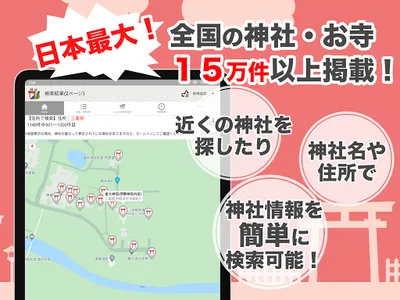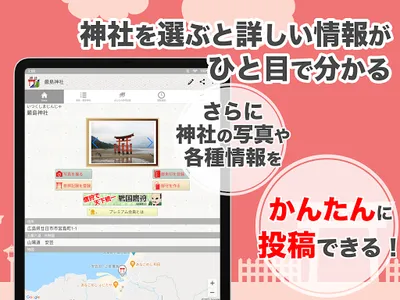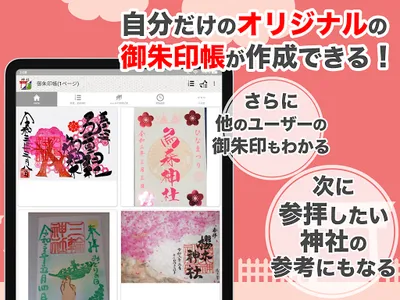No. 1 overall AppStore app
Surname derived net official app (free)
Surname-derived net app downloads exceeded 3 million!!
The number of Goshuin and worship posts exceeded 1.5 million!!
Free, easy one-touch search for over 150,000 temples and shrines!
You can easily search for nearby shrines, display them on a map in an easy-to-understand manner, and easily understand how to get there.
Of course, you can also search by shrine name and address.
Japan's largest! More than 150,000 shrines and temples are recorded, and you can understand everything about shrines with this one app!
If you keep a record of your visits and save the red stamps you receive in the red stamp book of this app, it will become a memory of your trip!
If you visit many shrines, you have a chance to be ranked!
It is also recommended for those who want to become a Shinto priest, a shrine maiden, a shrine girl, a goshuin girl, a goshuin boy, a goshuin girl, a shrine boy, a shrine girl, a rekijo, and anyone looking for a matchmaking.
■ Features of the app
・It is a "shrine encyclopedia" that aims to cover 100% of shrine information by updating and adding information on Japanese shrines at any time.
・You can share information about the shrine immediately by linking with various SNS such as twitter and Facebook.
- Shrine information can be easily added and edited, and users can easily post the information they have.
・You can leave a photo of the shrines you have visited so far as a "worship record".
・In the "Goshuincho", you can record the Goshuin you received at the shrine you visited.
・In the shrine access ranking, you can see at a glance the shrines that are trending right now.
・You can now "Like" information about your favorite visits.
・In the user contribution ranking, you can see who has visited the shrine with the highest number of worshipers and who has the highest rating.
・"Search by location" function that allows you to specify a location from the map or search for shrines near famous buildings.
・You can register favorite shrines and shrines you are interested in as favorites.
・Frequently used search conditions and detailed search conditions can be saved as favorite search conditions.
・It is very convenient when deciding group actions for school excursions.
・An app rooted in traditional Japanese culture.
*Some premium member functions
■ What is a shrine?
It is a facility that enshrines God in Japanese Shinto.
Since ancient times, the Japanese have always practiced reverence for God throughout their lives. Not only the life of ○○, but also the gods enshrined, such as mountain gods and sea gods, are very diverse.
It is based on the idea of 8 million gods, where gods dwell in all things.
A shrine is a place where many people pray, worship, and exorcise to exorcise all kinds of disasters, and invite family safety, good fortune, and prosperous business.
There are histories such as Jomon, Yayoi, Yamato, Asuka, Nara, Heian, Kamakura, Muromachi, Sengoku, Edo, Meiji, Taisho, and Showa eras, and we have bills and shrines at home.
Traditional Japanese techniques can be seen in shrine architecture.
The prayers and prayers performed at shrines include the following.
First shrine visit, Shichi-go-san, traffic safety, new car exorcism, family safety, love fulfillment, work safety, business prosperity, travel safety, success prayer, yakuharai (prayer for warding off evil), childbirth, easy delivery, recovery from illness, prayer for victory, Happo-yoke・Coming-of-age celebrations, naming, longevity celebrations, weddings, prayers for financial luck, good luck, etc.
Prayers at Jingu (Ise Jingu) pray for the Imperial Family's prosperity, national security, bountiful harvest, gratitude to the gods, family safety, physical health, business prosperity, business prosperity, safe childbirth, shrine visits, academic success, traffic safety, and exorcism.・There are disaster relief, wish fulfillment, illness recovery, etc.
There are the following prayers and prayers that can be requested and performed at shrines.
Ground-breaking ceremony, ridge-raising ceremony, opening ceremony, unveiling ceremony, burning-in ceremony, completion ceremony, new house festival, house god festival, store opening, closing purification ceremony, launching ceremony, safety festival, and others.
At the shrine, "Hatsuho-ryo" is dedicated as a sign of gratitude for the bountiful harvest of rice that is harvested for the first time every year.
On the "noshibukuro", write "firstfruits", "firstfruits fee", "tamagushi fee", etc. When you visit the shrine, you will pay an offering.
"Happo" means north (child "ne"), northeast (艮 "Ushitora"), east (U "U"), southeast (Tatsumi "Tatsumi"), south (Go "Uma"), southwest (Kon). "Hitsujisaru"), West (Rooster "Tori"), and Northwest (Inui "Inui").
Since ancient times, based on these eight directions, the five elements of Yin and Yang, ten Chinese zodiac signs, nine stars, etc. have been arranged to determine the fortunes of residence, direction, fortune, etc., and to ward off the eight directions.
It may involve the position of the earth, the universe, the sun, moon, stars, celestial bodies, planets, satellites, and the solar and lunar calendars. Mt.Fuji worship is also practiced throughout Japan.
Throughout the year in Japan, there are annual events at shrines.
New Year's visit, Nanakusa, Kagamibiraki, New Year's Eve on the 14th, Little New Year's Day, Setsubun, Hatsuuma, Needle Memorial Service, Hinamatsuri, Higan, Shrine Day, Spring Festival, Tango, Summer Eve Purification, Tanabata, Spirit Festival, Floating Lanterns, Chrysanthemum Festival, Jugoya, Ten Three nights, Ebisu-ko, tenth night, forgetting the year, beginning of the new year, sweeping soot, greeting the pine tree, exorcising the new year, toshikoshi (New Year's Eve)
A power spot is a special place dotted around the earth and is an "energy spot".
Many of the power spots are said to be "water" that heals people, and are considered to be places with the most energy. Many shrines exist in places associated with water.
・Famous shrines
Hokkaido Shrine, Ubagami Daijingu Shrine, Iwakiyama Shrine, Komagata Shrine, Mt. Shrines, Suzaki Shrine, Awa Shrine, Ono Shrine, Samukawa Shrine, Amatsu Shrine, Ita Shrine, Totsu Shrine, Yahiko Shrine (Mausoleum), Yahiko Shrine, Imizu Shrine, Futami Imizu Shrine, Keta Shrine, Takase Shrines, Oyama Shrine (Mine Headquarters), Oyama Shrine (Chugu Prayer Hall), Oyama Shrine (Maedate Shrine), Ishibe Shrine, Shirayama Hime Shrine, Kehi Shrine, Sengen Shrine, Suwa Taisha Shrine, Hida Ichinomiya Mizunashi Shrine, Nangu Taisha, Mishima Taisha, Mishima Taisha (Mishima Taisha), Mt. Isaha Shrine, Kanokuni Shrine, Kamowakeikazuchi Shrine, Kamomioya Shrine, Kono Shrine, Katano Shrine, Zama Shrine, Zama Shrine, Sumiyoshi Taisha, Sumiyoshi Taisha (Sumiyoshi Grand Shrine), Hiraoka Shrine, Italy Wa Shrine, Izushi Shrine, Awaga Shrine, Izanagi Shrine, Idakiso Shrine, Ube Shrine, Kumano Taisha, Izumo Taisha, Mononobe Shrine, Mizuwakasu Shrine, Yurahime Shrine, Nakayama Shrine, Kibitsuhiko Shrine, Ishigami cloth Miyakotama Shrine, Anhito Shrine, Kibitsu Shrine, Susanoo Shrine (Tode), Itsukushima Shrine, Tamasu Shrine, Sumiyoshi Shrine, Ichinomiya Shrine, Tensekimonbetsu Yakurahime Shrine, Kamiichinomiya Oawa Shrine, Oasahiko Shrine, Tamura Shrines, Oyamazumi Shrine, Tosa Shrine, Hakozaki Shrine, Hakata Sumiyoshi Shrine, Kora Taisha Shrine, Yodohime Shrine (Kawakami Shrine), Chikuri Hachiman Shrine, Kaijin Shrine, Hachimangu Shrine, Ko Shrine, Amote Nagao Shrine, Aso Shrine, Nishikan Ta Shrine (Kanda), Kusuhara Hachimangu Shrine, Usa Shrine, Miyake Shrine, Tsuno Shrine, Hiramon Shrine, Nitta Shrine, Kagoshima Shrine, Masuku Shrine, Naminoue Shrine, Katori Shrine, Takebe Taisha Shrine, Keta Taisha Shrine, Shiogama Shrine, Meiji Jingu Shrine, Gokoku Shrine, Yasukuni Shrine, Yasaka Shrine, Sakuragi Shrine
■ Various shrine tours are also included
Ise Jingu (125 Jingu Shrines), Ichinomiya Nationwide, Sosha Shrine of the Reigning Country, Engishikinai Shrine, Kokushimi Zaisha Shrine, 22 Shrines, Kenmu Chuko 15 Shrines, Gokoku Shrine designated by the Minister of Home Affairs, Imperial Festival Shrine, Beppyo Shrine, Tokyo Ten Shrines
――――――――――――――――――――
■ About inquiries
Thank you for your valuable opinions and impressions in the reviews. All the management have been allowed to see it, but if you have any inquiries or trouble information regarding the application, please contact us from the following.
http://www.recstu.co.jp/contact_app.html
Thank you.
――――――――――――――――――――
■ About surname-derived net
The number of surnames (surnames) in Japan is less than 300,000, according to the "Japanese Surname Encyclopedia" by Mr. Motoji Niwa, a surname researcher and doctor of literature.
It is said that there are nearly 300,000 surnames, and surname-derived net covers more than 99.04% of the surnames of the total population of Japan. .
■ Remarks
The shrine ga nice app works while connected to the network.
――――――――――――――――――――
I like shrines/I like temples website https://jinja-bukkaku.net (No.1 user number, open to public since 2013!!)
Surname derived net website https://myoji-yurai.net
twitter http://twitter.com/myoji_yurai
facebook http://www.facebook.com/298141996866158
Surname derived net official app (free)
Surname-derived net app downloads exceeded 3 million!!
The number of Goshuin and worship posts exceeded 1.5 million!!
Free, easy one-touch search for over 150,000 temples and shrines!
You can easily search for nearby shrines, display them on a map in an easy-to-understand manner, and easily understand how to get there.
Of course, you can also search by shrine name and address.
Japan's largest! More than 150,000 shrines and temples are recorded, and you can understand everything about shrines with this one app!
If you keep a record of your visits and save the red stamps you receive in the red stamp book of this app, it will become a memory of your trip!
If you visit many shrines, you have a chance to be ranked!
It is also recommended for those who want to become a Shinto priest, a shrine maiden, a shrine girl, a goshuin girl, a goshuin boy, a goshuin girl, a shrine boy, a shrine girl, a rekijo, and anyone looking for a matchmaking.
■ Features of the app
・It is a "shrine encyclopedia" that aims to cover 100% of shrine information by updating and adding information on Japanese shrines at any time.
・You can share information about the shrine immediately by linking with various SNS such as twitter and Facebook.
- Shrine information can be easily added and edited, and users can easily post the information they have.
・You can leave a photo of the shrines you have visited so far as a "worship record".
・In the "Goshuincho", you can record the Goshuin you received at the shrine you visited.
・In the shrine access ranking, you can see at a glance the shrines that are trending right now.
・You can now "Like" information about your favorite visits.
・In the user contribution ranking, you can see who has visited the shrine with the highest number of worshipers and who has the highest rating.
・"Search by location" function that allows you to specify a location from the map or search for shrines near famous buildings.
・You can register favorite shrines and shrines you are interested in as favorites.
・Frequently used search conditions and detailed search conditions can be saved as favorite search conditions.
・It is very convenient when deciding group actions for school excursions.
・An app rooted in traditional Japanese culture.
*Some premium member functions
■ What is a shrine?
It is a facility that enshrines God in Japanese Shinto.
Since ancient times, the Japanese have always practiced reverence for God throughout their lives. Not only the life of ○○, but also the gods enshrined, such as mountain gods and sea gods, are very diverse.
It is based on the idea of 8 million gods, where gods dwell in all things.
A shrine is a place where many people pray, worship, and exorcise to exorcise all kinds of disasters, and invite family safety, good fortune, and prosperous business.
There are histories such as Jomon, Yayoi, Yamato, Asuka, Nara, Heian, Kamakura, Muromachi, Sengoku, Edo, Meiji, Taisho, and Showa eras, and we have bills and shrines at home.
Traditional Japanese techniques can be seen in shrine architecture.
The prayers and prayers performed at shrines include the following.
First shrine visit, Shichi-go-san, traffic safety, new car exorcism, family safety, love fulfillment, work safety, business prosperity, travel safety, success prayer, yakuharai (prayer for warding off evil), childbirth, easy delivery, recovery from illness, prayer for victory, Happo-yoke・Coming-of-age celebrations, naming, longevity celebrations, weddings, prayers for financial luck, good luck, etc.
Prayers at Jingu (Ise Jingu) pray for the Imperial Family's prosperity, national security, bountiful harvest, gratitude to the gods, family safety, physical health, business prosperity, business prosperity, safe childbirth, shrine visits, academic success, traffic safety, and exorcism.・There are disaster relief, wish fulfillment, illness recovery, etc.
There are the following prayers and prayers that can be requested and performed at shrines.
Ground-breaking ceremony, ridge-raising ceremony, opening ceremony, unveiling ceremony, burning-in ceremony, completion ceremony, new house festival, house god festival, store opening, closing purification ceremony, launching ceremony, safety festival, and others.
At the shrine, "Hatsuho-ryo" is dedicated as a sign of gratitude for the bountiful harvest of rice that is harvested for the first time every year.
On the "noshibukuro", write "firstfruits", "firstfruits fee", "tamagushi fee", etc. When you visit the shrine, you will pay an offering.
"Happo" means north (child "ne"), northeast (艮 "Ushitora"), east (U "U"), southeast (Tatsumi "Tatsumi"), south (Go "Uma"), southwest (Kon). "Hitsujisaru"), West (Rooster "Tori"), and Northwest (Inui "Inui").
Since ancient times, based on these eight directions, the five elements of Yin and Yang, ten Chinese zodiac signs, nine stars, etc. have been arranged to determine the fortunes of residence, direction, fortune, etc., and to ward off the eight directions.
It may involve the position of the earth, the universe, the sun, moon, stars, celestial bodies, planets, satellites, and the solar and lunar calendars. Mt.Fuji worship is also practiced throughout Japan.
Throughout the year in Japan, there are annual events at shrines.
New Year's visit, Nanakusa, Kagamibiraki, New Year's Eve on the 14th, Little New Year's Day, Setsubun, Hatsuuma, Needle Memorial Service, Hinamatsuri, Higan, Shrine Day, Spring Festival, Tango, Summer Eve Purification, Tanabata, Spirit Festival, Floating Lanterns, Chrysanthemum Festival, Jugoya, Ten Three nights, Ebisu-ko, tenth night, forgetting the year, beginning of the new year, sweeping soot, greeting the pine tree, exorcising the new year, toshikoshi (New Year's Eve)
A power spot is a special place dotted around the earth and is an "energy spot".
Many of the power spots are said to be "water" that heals people, and are considered to be places with the most energy. Many shrines exist in places associated with water.
・Famous shrines
Hokkaido Shrine, Ubagami Daijingu Shrine, Iwakiyama Shrine, Komagata Shrine, Mt. Shrines, Suzaki Shrine, Awa Shrine, Ono Shrine, Samukawa Shrine, Amatsu Shrine, Ita Shrine, Totsu Shrine, Yahiko Shrine (Mausoleum), Yahiko Shrine, Imizu Shrine, Futami Imizu Shrine, Keta Shrine, Takase Shrines, Oyama Shrine (Mine Headquarters), Oyama Shrine (Chugu Prayer Hall), Oyama Shrine (Maedate Shrine), Ishibe Shrine, Shirayama Hime Shrine, Kehi Shrine, Sengen Shrine, Suwa Taisha Shrine, Hida Ichinomiya Mizunashi Shrine, Nangu Taisha, Mishima Taisha, Mishima Taisha (Mishima Taisha), Mt. Isaha Shrine, Kanokuni Shrine, Kamowakeikazuchi Shrine, Kamomioya Shrine, Kono Shrine, Katano Shrine, Zama Shrine, Zama Shrine, Sumiyoshi Taisha, Sumiyoshi Taisha (Sumiyoshi Grand Shrine), Hiraoka Shrine, Italy Wa Shrine, Izushi Shrine, Awaga Shrine, Izanagi Shrine, Idakiso Shrine, Ube Shrine, Kumano Taisha, Izumo Taisha, Mononobe Shrine, Mizuwakasu Shrine, Yurahime Shrine, Nakayama Shrine, Kibitsuhiko Shrine, Ishigami cloth Miyakotama Shrine, Anhito Shrine, Kibitsu Shrine, Susanoo Shrine (Tode), Itsukushima Shrine, Tamasu Shrine, Sumiyoshi Shrine, Ichinomiya Shrine, Tensekimonbetsu Yakurahime Shrine, Kamiichinomiya Oawa Shrine, Oasahiko Shrine, Tamura Shrines, Oyamazumi Shrine, Tosa Shrine, Hakozaki Shrine, Hakata Sumiyoshi Shrine, Kora Taisha Shrine, Yodohime Shrine (Kawakami Shrine), Chikuri Hachiman Shrine, Kaijin Shrine, Hachimangu Shrine, Ko Shrine, Amote Nagao Shrine, Aso Shrine, Nishikan Ta Shrine (Kanda), Kusuhara Hachimangu Shrine, Usa Shrine, Miyake Shrine, Tsuno Shrine, Hiramon Shrine, Nitta Shrine, Kagoshima Shrine, Masuku Shrine, Naminoue Shrine, Katori Shrine, Takebe Taisha Shrine, Keta Taisha Shrine, Shiogama Shrine, Meiji Jingu Shrine, Gokoku Shrine, Yasukuni Shrine, Yasaka Shrine, Sakuragi Shrine
■ Various shrine tours are also included
Ise Jingu (125 Jingu Shrines), Ichinomiya Nationwide, Sosha Shrine of the Reigning Country, Engishikinai Shrine, Kokushimi Zaisha Shrine, 22 Shrines, Kenmu Chuko 15 Shrines, Gokoku Shrine designated by the Minister of Home Affairs, Imperial Festival Shrine, Beppyo Shrine, Tokyo Ten Shrines
――――――――――――――――――――
■ About inquiries
Thank you for your valuable opinions and impressions in the reviews. All the management have been allowed to see it, but if you have any inquiries or trouble information regarding the application, please contact us from the following.
http://www.recstu.co.jp/contact_app.html
Thank you.
――――――――――――――――――――
■ About surname-derived net
The number of surnames (surnames) in Japan is less than 300,000, according to the "Japanese Surname Encyclopedia" by Mr. Motoji Niwa, a surname researcher and doctor of literature.
It is said that there are nearly 300,000 surnames, and surname-derived net covers more than 99.04% of the surnames of the total population of Japan. .
■ Remarks
The shrine ga nice app works while connected to the network.
――――――――――――――――――――
I like shrines/I like temples website https://jinja-bukkaku.net (No.1 user number, open to public since 2013!!)
Surname derived net website https://myoji-yurai.net
twitter http://twitter.com/myoji_yurai
facebook http://www.facebook.com/298141996866158
Show More














